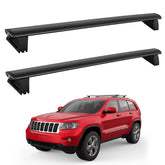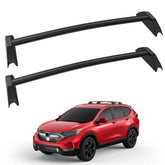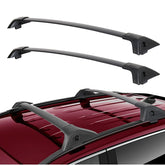How to maintain your roof racks?
My friends, do you often drive to outdoor activities or travel adventures? If you have a roof rack installed on your car, you must have deeply felt the huge storage space it provides you. It has become an indispensable accessory in the lives of modern car owners, making travel more convenient and flexible.
It should be noted that anything left outdoors for a long time needs maintenance to ensure that it has a long enough service life. Roof racks are exposed to ruthless attacks such as rain, sun, snow, and dust, which will gradually wear out your system. Proper care and maintenance are essential to ensure that the roof rack can maintain its best condition and continue to function. In this article, we will introduce some tips for keeping the roof rack so that your roof rack can continue to serve you for many years.
Use the right products for cleaning
When you’re cleaning your car roof rack, it’s important to use the right cleaning products, or you’ll damage the material of your rack. When choosing cleaning products, look for ones that are pH neutral and don’t contain harsh chemicals like alcohol, bleach, or ammonia. Of course, you can also choose dedicated roof rack cleaners and car washes that are safe to use on all parts of your vehicle.
The cleaning tools you use are also very particular. Before using a cleaner to remove dirt or stains, you can use a brush or rag to remove surface debris. After applying the cleaning solution, use a sponge or soft cloth to wipe the surface of the roof rack. By using the right cleaning products, your roof rack will be kept in top condition.

Clean regularly
Debris, road salt, and even grime from your gear can accumulate on your roof rack, gradually causing wear and tear over time. The key to a long-lived roof rack? Regular cleaning. Whether it's a deep clean after a long trip or a routine wipe, keep your roof rack free of dust and dirt. Regular cleaning helps preserve the appearance and life of your roof rack.
When cleaning your roof rack, you can follow these steps:
- Prepare your tools: Prepare a soft-bristle brush, detergent, warm water, a rag, and a sponge.
- Remove dust and debris: Use a soft-bristle brush or vacuum to remove dust and debris from the surface.
- Clean the surface: Scrub the rack with a mixture of warm water and detergent, focusing on the corners.
- Rinse and dry: Rinse the detergent residue with clean water and finally wipe dry with a clean cloth. Let the rack dry completely.
Inspect regularly
Regular inspections are the first line of defense against premature wear on your roof rack. Look for signs of wear: cracks, loose bolts, or rust. Pay special attention to mounting hardware, such as nuts and bolts. Screws and fasteners can loosen over time from vibration and weather exposure. A quick check every few months can save you from the annoyance of losing your luggage on the highway.
You can test whether the roof rack is securely fixed by shaking it. If there is movement, follow these steps to correct it:
- Remove the roof rack once and then reinstall it.
- Check that all bolts and clamps are tight and ready to go.
- Replace worn parts
Lubricate
Many roof racks have sliding parts or folding mechanisms, and lubrication is very important to ensure that it can operate smoothly. Spraying lubricant can help keep the parts running smoothly. At the same time, lubrication can reduce friction and prevent rust, avoiding long-term damage. When using lubricants, use silicone-based lubricants or spray-on rust inhibitors to apply to the roof rack. Avoid using greasy lubricants because they attract dust and dirt. After application, remember to wipe off the excess lubricant. If you often travel long distances, it is recommended to lubricate the roof rack at least 2 times a year or more.

Store properly
When not in use, your roof rack should be stored in a dry, cool place, preferably indoors or under a cover. Prolonged exposure to extreme temperatures or humidity can cause plastics to degrade. If left outdoors, they can easily rust or fade. If you have to leave it outside, use a protective bag or cover to protect it from the sun and rain. When your roof rack is not needed, remove it from your vehicle and store it in a garage or shed. Remember to hang it or lay it flat to avoid pressure on one side.
Keep spare parts
Roof racks are built to last, but they eventually wear out. Having spare parts on hand, like spare bolts, washers, and locks, can help you avoid frustration if damage or loss occurs, especially when you're on the road. You can find replacement parts directly from the manufacturer or at a reputable auto parts store. A small stockpile of the essentials ensures you're not stuck with an incomplete or inoperable roof rack.
Do not overload
One of the most common reasons for roof rack damage is overloading. Roof racks are designed with a specific weight capacity in mind, and exceeding this limit will compromise its structural integrity. It may look strong, but even the strongest materials have their limits. Overloading can cause irreparable damage to the rack and create serious safety hazards such as swaying, instability, increased wind resistance, and affect the handling of the vehicle, making it unsafe on the road. Therefore, it is important to use your roof rack properly, understand its weight limit, and strictly adhere to it to prevent it from being damaged or deformed. Distribute the load evenly on the rack, with heavy items in the middle and lighter items on the sides. Finally, secure the items properly with straps or belts.

Wash the car carefully
When you have a roof rack installed on your car, you need to be more careful when washing your car. Be gentle when cleaning the rack to avoid scratching or damaging the surface. The best way is to remove the roof rack before washing the car. Many car owners take their cars to the car wash with the roof rack installed. The harsh brushes or abrasive materials of many automatic car washes are likely to cause scratches, nicks, and even break parts of the roof rack. Therefore, we strongly recommend washing the car by hand, using a soft microfiber cloth or sponge to clean all the nooks and crannies without causing damage.
Prevent corrosion
If you live in an area with high humidity or winter road salt, corrosion is one of the biggest threats to your roof rack. Rust prevention is especially important for metal roof racks. You can prevent corrosion by regularly inspecting your rack for early signs, such as rust spots or discoloration. After cleaning, dry the rack thoroughly to avoid moisture buildup, and consider applying a coat of rust protection, especially to areas of the roof rack where the surface appears worn or scratched. A quick spray of rust inhibitor every season can make a huge difference.
Remove rust
Rust can be a stubborn enemy, but it is not invincible. If you notice rust on your roof rack, act quickly. Use a wire brush or a special rust remover to scrub away the corrosion. After removing the rust, sand the area smooth and apply a coat of protective paint or rust sealant. Doing this promptly can prevent the rust from spreading and causing further damage.

Conclusion
Maintaining your roof rack may seem like a small thing, but the benefits are huge. A little attention can go a long way toward extending the life of your racks, ensuring they're ready for anything you throw at them. From cleaning and inspection to lubrication and rust prevention, these steps are simple yet effective ways to keep your roof racks in tip-top shape. So don't neglect them—after all, they're more than just an accessory; they're an important part of your vehicle's load-bearing capacity.
Featured Products
- $83.99
- $83.99
- Unit price
- / per
- $85.99
$138.90- $85.99
- Unit price
- / per
- $69.99
- $69.99
- Unit price
- / per
- $98.99
- $98.99
- Unit price
- / per














